21 Exciting Winter Photography Tips and Ideas to Try
Winter may not seem the best time of year for exciting photoshoots and gorgeous photos. But it’s the best season for creating surreal and dreamy images.
Look at our 21 tips and creative ideas to maximize winter photography. We’ve also included a bonus section of tips on how to keep your gear safe.
[highlight type=”short” price=”no” toc=”no” title=”The Creative Photography Cookbook” badge=”Project-Based eBook & Cheat Sheets” product=”30976″]Unlock your photography potential with this Project-Based eBook and Cheat Sheets:
- Explore unlimited creative inspiration for captivating scenes.
- Master fun techniques with balance, levitation, steam, and more.
- Simple setups at home with basic gear for stunning results.
[/highlight]
21 Tips for Winter Photography
If you are interested in winter photography, you must prepare for cold weather. Dressing properly often means wearing the warmest clothing you have.
Taking a hot beverage in a thermos is a great way to stay warm, especially if you’re shooting from one spot. It’s also a good idea to invest in photography gloves.
Staying warm is the foundation of every other tip for outdoor photography ideas in winter. So, continue with the rest of our tips!
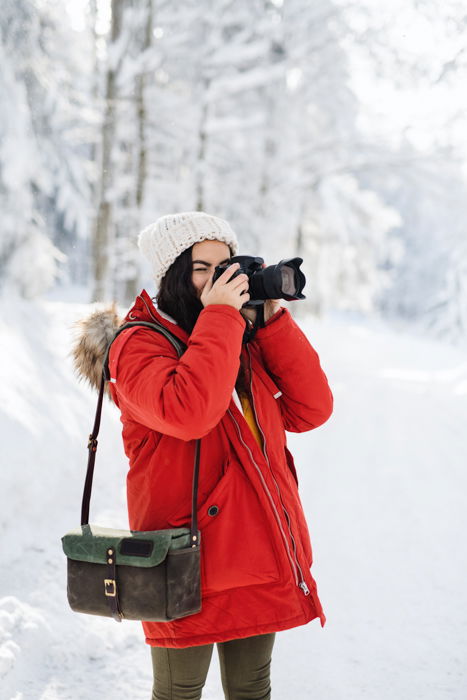
1. Change Camera Settings to Enhance Soft Lights
Shooting in snow is challenging because much of your image will be bright white. One solution is to overexpose your photos in wintertime. It means that you can let more light into your camera. Open the aperture wider or use a slow shutter speed.
This way, you can achieve a soft effect. Gentle ambient light works well for overexposed pictures and looks good in a landscape, especially when everything is covered in snow. A fast shutter speed or a small aperture can result in dark images.
You can also experiment with your camera’s white balance settings. Modifying the color temperature slightly can transform snowy scenes into magical ones.
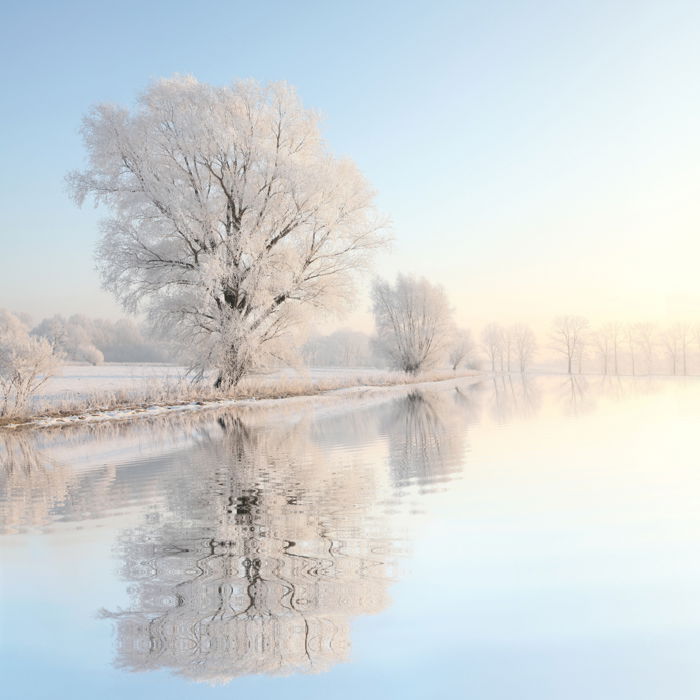
2. Have a Winter-Themed Portrait Photoshoot
Winter photography goes hand in hand with warm outfits. And faux fur animal hats are perfect for outdoor photoshoots.
Asking your model to stand in the snow might not seem great. But if you use the right outfits and props, everyone will be fine. Snow makes your images more fabulous—almost as if you were illustrating a storybook.
Portrait photography doesn’t always have to feature fancy dresses and accessories. A cozy outfit can make your photos look more heartwarming than a summer portrait.
There are typical accessories you can use. Scarves, hats, hooded coats, gloves, or boots can all be stylish elements of your images.
You can decide what effect you want to achieve and ask your subject to dress accordingly.
You can ask them to dress in vivid colors to contrast the snow and their clothes. But you can also make them a part of the background and the scene by using cold colors, such as blue and grey.
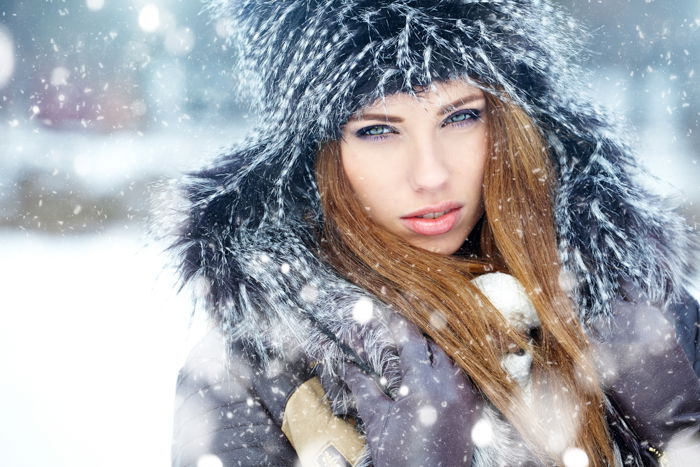
3. Take Photos of Couples to Bring Warmth Into Winter Photoshoots
Winter photography is becoming more popular for engagement photos or other couple photos.
A little snow adds a lot to the atmosphere of the images. In most countries, snowy days are rarer than warm and sunny ones. So, winter photos in snow-covered environments make the images look even more special.
The contrast between the cold temperatures and the smiling faces will help you take heartwarming photos. Use the cold weather to bring the couple closer to each other. Hugs, shared coats, and holding hands in gloves all look nice in winter photoshoots.
You can take a cute self-portrait with you if you have a significant other. It’s a good idea to have a few poses in mind before you get out into the cold. Make sure to make these photoshoots as short as possible to prevent frozen smiles!
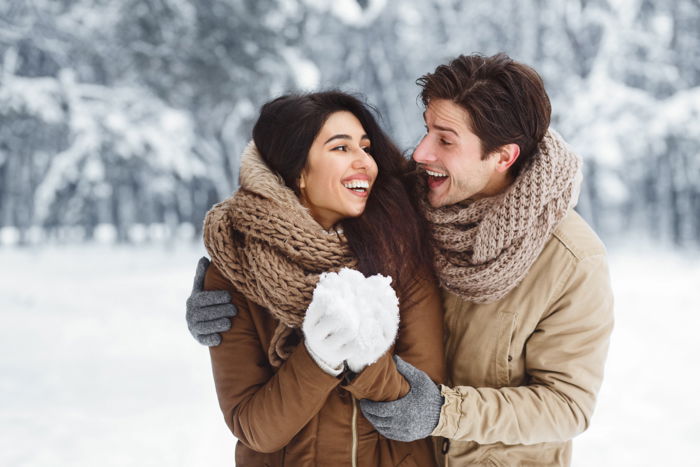
4. Use Winter Fog to Take Moody Photos of People
Winter photography tips aren’t just about sparkly snow and cozy evenings. You can take moody photos even when the sun seems to be hiding. For example, you can use winter fog as an eerie background. It brings out the lonely and cold side of winter.
Cold days can be gloomy and a bit depressing with their long nights. To capture this, your model can stare off into the distance with their back to your camera. Their figure should be small compared to the background.
The brightness of the snow will give you enough light to create images similar to the one below.
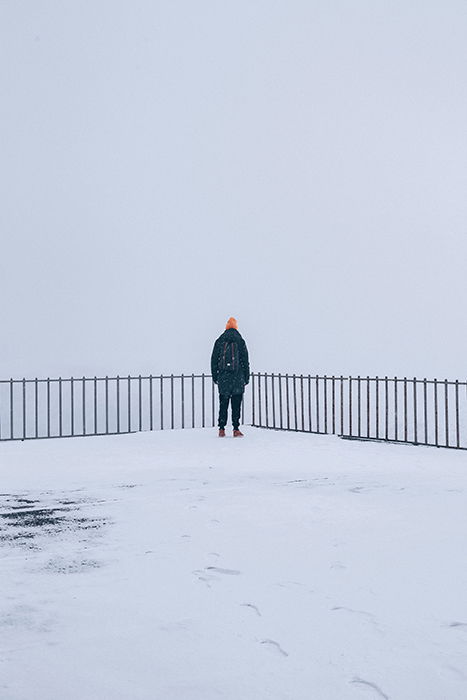
5. Take Wildlife Photos During Winter
Winter might not be ideal for sitting outside for hours while waiting for a wild animal to pass by. Yet, snow-covered environments can provide a great backdrop to the animals you spot.
If you don’t want to wander in the cold winter, you can attract animals to your garden or window. Just place food for birds in a feeder, and they will come to you.
You can start feeding them when the first frost comes. Then, continue it until spring. If they get used to a place where they can find food, they will return regularly. You’ll have many opportunities to shoot wildlife from the comfort of your living room.
Winter is ideal for bird photoshoots because of its perfectly white tones. This makes it the perfect background for simple yet eye-catching photos.
Because winter photography usually consists of dull colors, things can blend unflatteringly. This might take attention away from your subject. To blur out background distractions, use a large aperture like f/1.4.
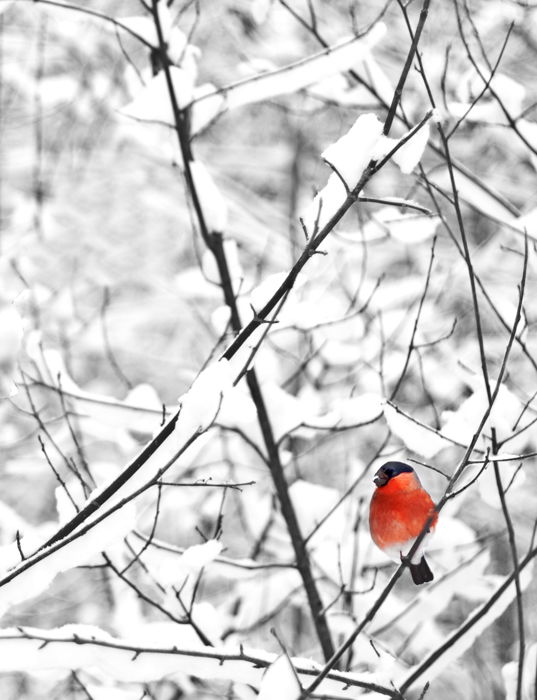
6. Make the Most Out of Christmas Photography
For many people, one of the highlights of winter is Christmas. All the reds and greens are a breath of fresh air during this season.
Even if you do not like shooting in cold winter, you’ll love taking Christmas-themed photos.
Christmas-themed flat lays are a great way to highlight the best parts of winter photography. You can photograph your favorite objects, like cups or tree decorations, from a bird’s eye view.
Of course, not only flat lays work here. Shoot from the side using a shallow depth of field. Blurred lights in the background bring warmth even in cold weather.
To make this idea fun, take photos of what you love about Christmas. You can capture a handmade decoration or a childhood memory. Shooting the Christmas table setting is another way to get stunning images.
Once the photos are ready, you can turn them into album photos. You and your family will treasure them for years to come. You can even make postcards of them.
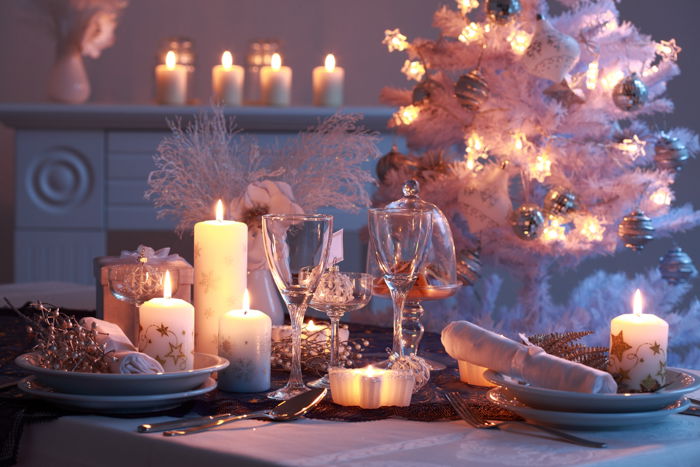
7. Use Food Photography to Capture the Winter Mood
Winter is the perfect time to stay in and cook something delicious. You can slow down a bit and take some time for food photography. This is one of those photography ideas for winter that you don’t have to leave your house for.
There are typical Christmas foods and typical winter beverages. Just by looking at their images, you can almost smell them.
You can make mulled wine, hot chocolate, tea, or even coffee served in a winter mug. Or you can bake some gingerbread, a cake, or anything that reminds you of winter.
Cooking proper Christmas dishes before or after Christmas just for fun would be a lot. So, It’s best if you experiment with smaller tasks, like simple cookies.
You can also capture the dishes at Christmas if you have the time before your family eats everything. These arranged food photography sessions are great preparation for holiday photography.
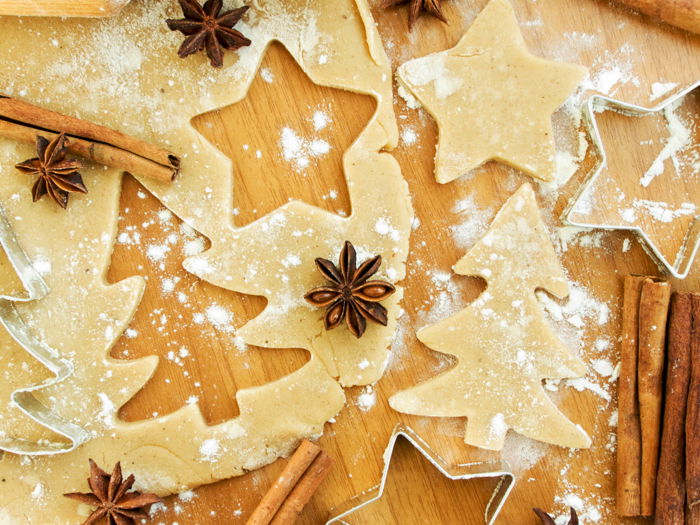
8. Take Macro Photos to Capture the Beauty of Winter
Winter isn’t always fun, making it difficult to be excited about photography this time of year. But winter isn’t all about gloominess and cold temperatures.
To inspire yourself, start a project focusing on winter’s beauty. One of the best ways to do that is to photograph snowflakes and frost.
Frost can be found anywhere and always looks stunning. Combining frost and natural sunlight can result in breathtaking photographs. This challenge will help you find beauty in simple places. And hopefully, cheer you up on a gloomy day!
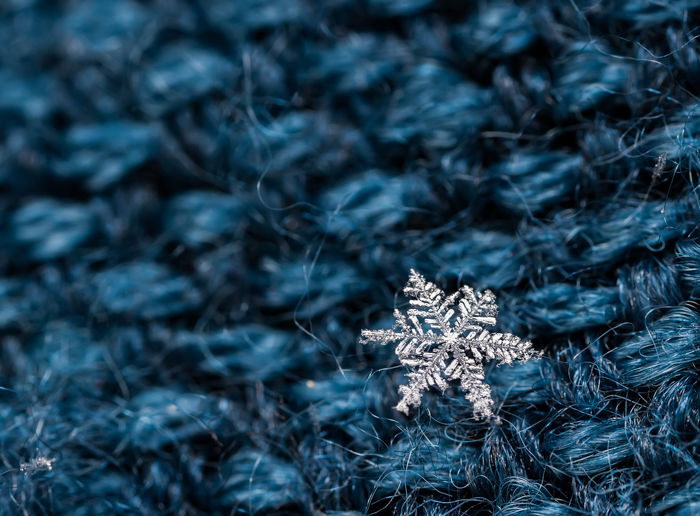
9. Freeze Soap Bubbles for Incredible Results
When it’s cold outside, you can blow some bubbles and create magic! You only need soap bubbles, a macro lens, and good lighting.
Soap bubbles can be difficult to work with, especially if it’s windy outside. It’s best to take bubble photos when the weather is calm.
Blow the bubbles in a location where they can land gently. Branches, flowers, and bushes are perfect for this. Shoot when the sun is high for the best lighting results.
Photos like this make winter photography more than just a challenging genre. If you’re lucky, your bubbles get covered in frost. This makes it seem like you captured snowflakes in a drop of water.
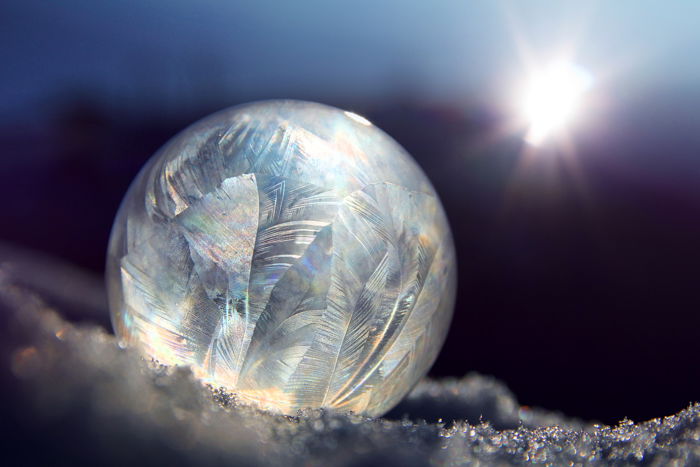
10. Create a Contrast With Autumn and Spring to Enhance the Power of Winter
You can find frozen leaves in winter displaying the remains of autumn. They are not only beautiful, but they also contrast nicely with the previous season.
The first signs of spring, such as little flowers growing from the snow-covered land, can also enhance the contrast between the two seasons.
These unique contrasts can remind the viewer of the essence of winter. It can beautifully freeze the world, but it doesn’t only mean death. Beautiful things can grow afterward. Look for these small signs and capture them to tell stories of nature and the circle of life.
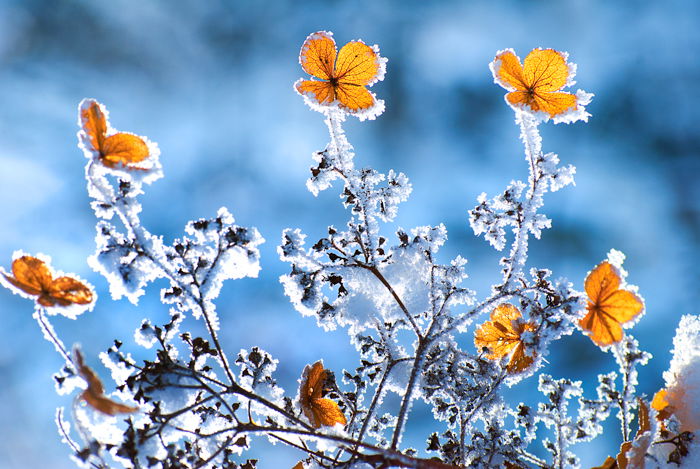
11. Focus on the Connection Between Buildings and Snow
The coldness of winter puts a spotlight on things we might overlook at other times of the year. For example, it’s impossible not to notice a vibrant light in a colorless, snowy scene.
If you’re a fan of architecture, snow can help your subjects stand out even more. Use all the negative space to lead a viewer’s eyes to a building. You can even emphasize shapes that aren’t that noticeable when trees, a blue sky, and a busy street surround them.
Architectural photography is usually not strongly connected to winter photography ideas. But if you try it, you’ll realize how different buildings can look at this time of the year.
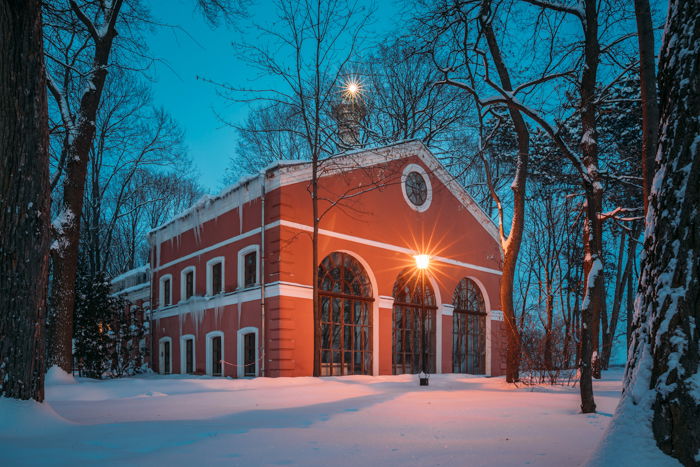
12. Take Landscape Images to Show the Magic of Winter
The winter snow makes everything look different. Go for a walk in a forest with your camera and capture the beauty of this season. Prepare for the cold weather, but a small hike can be a great activity if you keep moving.
You can shoot to enhance the golden lights. But this is not the only way to go. When it comes to winter photos, you might be tempted to make them as warm as possible for the lack of colors. But what if you did the exact opposite for a change?
Adjust your camera’s white balance to make your cold winter photos even colder. And experiment with different cool tones.
This exercise will help you think outside the box and encourage you to break the rules sometimes.
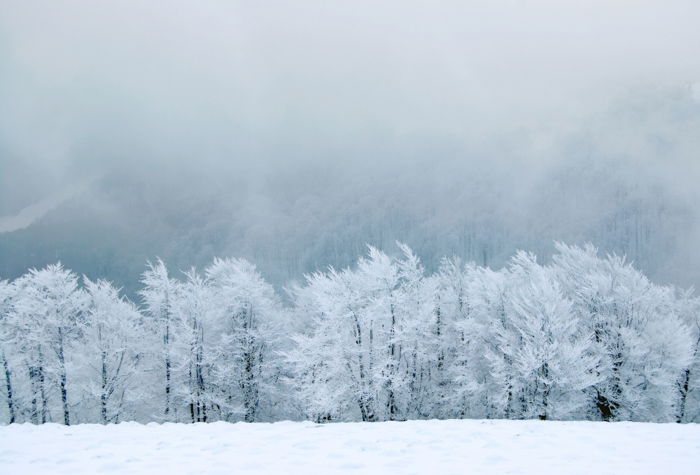
13. Get Up Early for Magical Light
As with everything in this season, winter sunrises are magical. Look at the to choose a sunny day. Morning light is usually colder than the light of a sunset. And it looks mesmerizing, reflecting off of the snow.
The best combination is morning fog with the first signs of a sunny day. The sun’s first rays can brighten the whole scene and make the mist look glowing.
You don’t necessarily need a snowy landscape to create stunning sunrise photos. Any kind of winter weather is worth a shot.
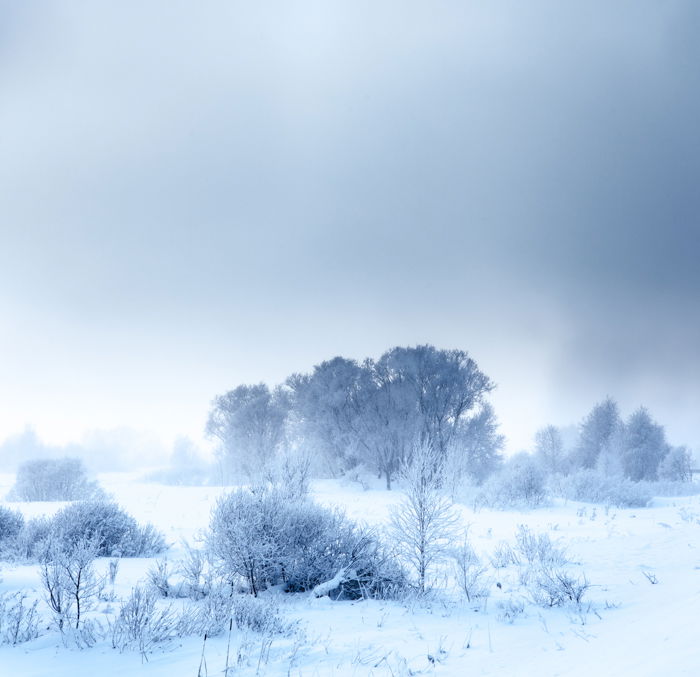
14. Capture Sunsets to Create Dramatic Contrast
Creating contrast is one of the best ways to take stunning winter photos. Use a vibrant sunset or sunrise to create outstanding nature photos if possible.
The dramatic difference between warm and cool tones will make your photos look striking and atmospheric. This is ideal for landscape photographers who want to capture winter’s gritty and vulnerable sides.
During the blue hour in winter, you can find perfect contrast with the white of the snow. Usually, the sky is lighter than the landscape itself. The dark blue sky of the blue hour will make a somewhat surreal contrast with the snow.
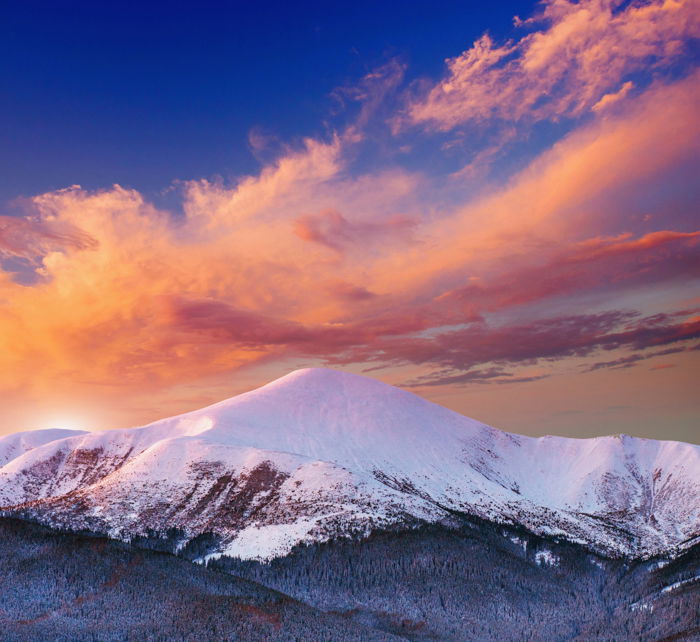
15. Take Creative Photos of Snow Falling to Make Playful Images
Falling snow is often used in winter photography. This idea is perfect for having fun and improving your action photography skills. You can capture the snowfall itself. But it’s even better to combine it with a portrait photography session.
The aim is to take sharp photos of falling snow and make your model stand out. To make this process easier, take photos using burst mode. Burst mode allows photographers to take multiple photos while holding the shutter.
You can also play with shutter speed to slightly blur the falling snow. This technique can let you take adorable and funny photos of people enjoying winter.
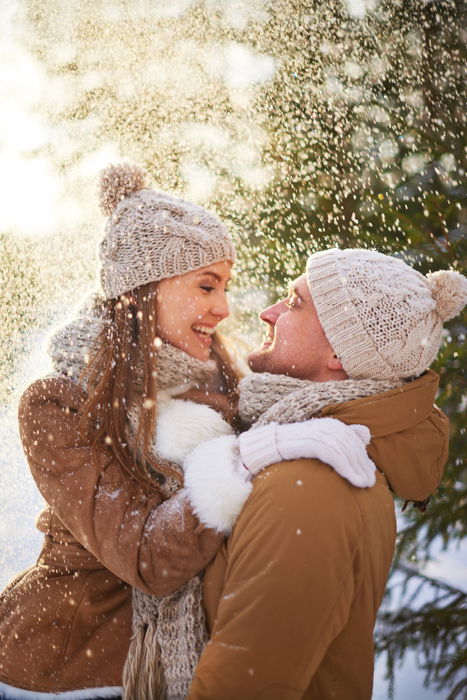
16. Take Adorable Photos of a Pet in Winter Clothes
Our winter photography tips are not just for humans and Christmas decorations. You need to own a pet for this idea. And if your pet loves spending time outdoors in the winter, you’re in luck!
Adorable pet photos are always in demand. You can turn your pet portraits into stunning works of art whenever you go out. Use colorful outfits and accessories to make your photos stand out.
If you like the results, you can use these images as Christmas postcards to your family or friends! Make sure to reward your pet with treats during and after your photoshoot.
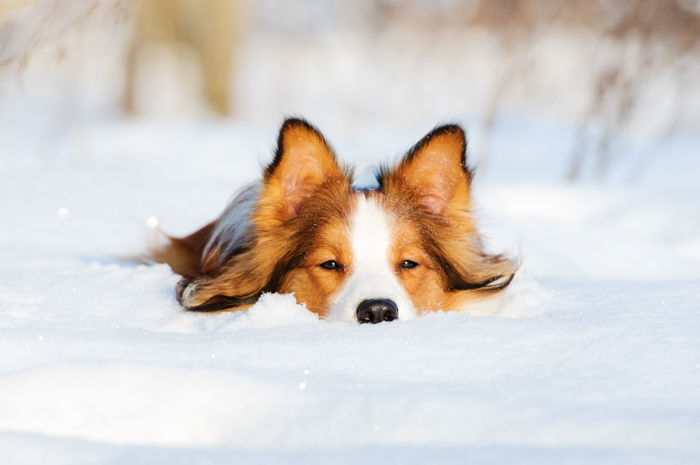
17. Don’t Forget to Take a Wintery Self-Portrait!
During this cold season, don’t forget to take a few photos of yourself surrounded by a stunning winter landscape. Your results will document your journey even if your face isn’t visible in your self-portraits.
You can even set up a home studio and practice with self-portraits. Shooting at home with your favorite Christmas decorations can create cozy memories.
But you don’t necessarily have to have a Christmas-themed portrait of yourself. Your favorite pullover can be more than enough.
They might even remind you how much you’ve progressed as an artist.
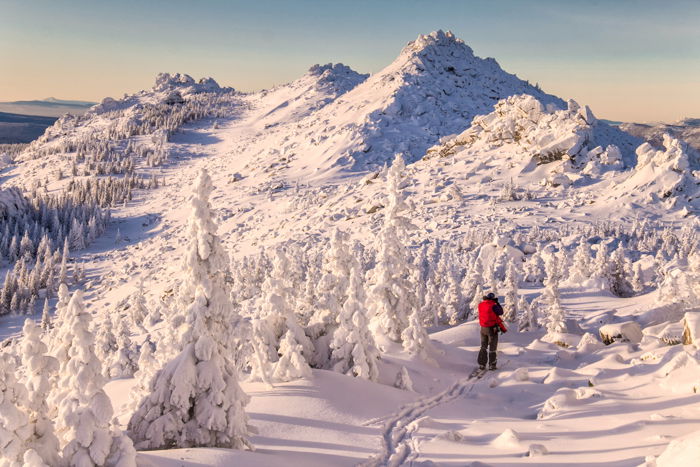
Top Tips for Using and Protecting Gear in Winter
Those are our best tips on winter photography. But before we go, we’ll tell you how to keep your expensive photography gear safe and working when the temperature drops.
18. Bring Extra Batteries
Keeping a camera operating in the cold can be one of the biggest challenges when the mercury drops. Cold temperatures increase the internal resistance in a battery, limiting how much electricity it can discharge.
On a warm day, a battery can discharge its available power. But you may only get 50% of the available power when the temperature drops below freezing.
The solution is pretty easy—carry multiple batteries! I keep at least a couple of spares in an inside pocket where they will stay warm. When one dies, I swap it out for a warm battery.
Alternating back and forth can extend the battery’s life. You can also shoot for hours longer than you would otherwise be able to.
19. Mind Your Breath
Batteries aren’t the only risk to your photoshoot during the winter. One, in particular, can ruin your day of photography. And that is your breath.
A mistimed, warm, humid breath will condense on your lens, resulting in a layer of milky frost on the glass. No sharpness will make up for that blur, no matter how much money you spend on your lenses.
Wiping at it usually smudges it more. And defrosting it inside (see below) can take hours.
Always watch where you breathe! If you turn your camera around to check lens settings, don’t exhale. I also usually wear a neck gaiter or balaclava that I pull up over my mouth and nose. Whatever method you choose to keep your breath off your lens, it’s important to always remember.
20. Use the Camera’s Lens Cap
Breath is the usual culprit of fogged lenses. But when shooting at night, there is always the chance that natural frost will form. Use your camera’s lens cap to avoid fogging your lens when you aren’t shooting.
If you are walking from one location to another, taking a break, or searching for a new composition, put the cap back on your lens.
21. Go Back Inside Safely
Last, and perhaps most importantly, is the return indoors. Do you know how a cold drink on a hot summer day gathers condensation? Ever watch those drips form and run down the glass, pooling in a messy ring on the hardwood table?
Now imagine that happening to your camera gear. It can, and it will.
If you bring a camera indoors that you’ve been using in cold temperatures, the equipment will be cold. After a frigid night photographing outside, an unprotected camera grows condensation seconds after coming inside.
This condensation can wreak havoc with the camera’s electronics. It can cause moisture to build up and fog the internal workings of lenses and bodies. I know from experience that it’s ugly and can wreck a camera!
Fortunately, it’s easy to deal with. When you return indoors to finish the day, place your camera and lenses into an airtight bag.
Ziplocks are good, but I favor lightweight roll-top dry bags. These are tough, reusable, and work well.
Once sealed tight in a zip lock or dry bag, condensation can’t contaminate your gear. Just let your camera warm up to room temperature before you pull it out of the bag.
Conclusion: Winter Photography Tips
Winter is coming, folks. Before it arrives, satisfy your creative needs with plans, mood boards, themes, and ideas. These will make your winter photography a success.
Consider our winter photography tips and experiment with them to get outstanding images. Snowy days are usually rare in most parts of the world. Your images are going to be more unique just by showing some snow. You’ll be ready to take your best photos when winter is here!
[highlight type=”short” price=”no” toc=”no” title=”The Creative Photography Cookbook” badge=”Project-Based eBook & Cheat Sheets” product=”30976″]Unlock your photography potential with this Project-Based eBook and Cheat Sheets:
Explore unlimited creative inspiration for captivating scenes.
Master fun techniques with balance, levitation, steam, and more.
Simple setups at home with basic gear for stunning results.
[/highlight]